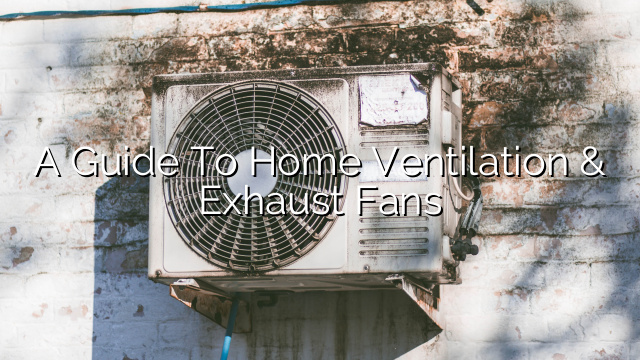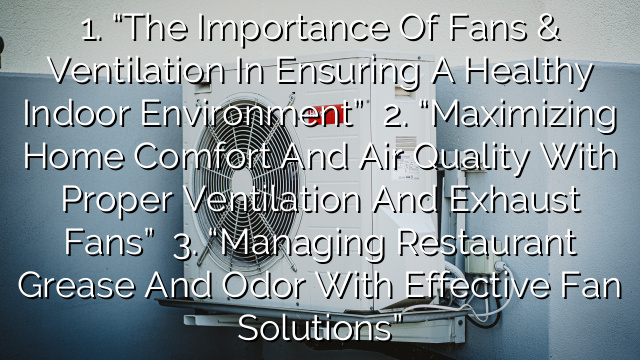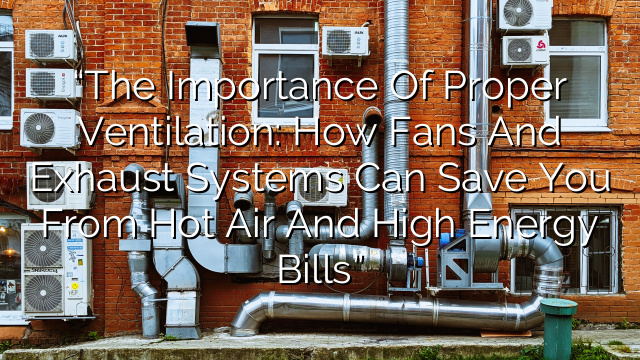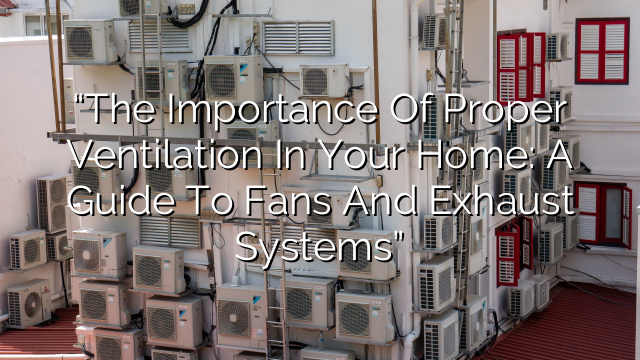Welcome to our Guide to Home Ventilation and Exhaust Fans!
Proper ventilation is essential for maintaining a healthy and comfortable living environment in your home. In this guide, we will explore the different types of home ventilation systems and exhaust fans, their benefits, installation tips, and answer frequently asked questions.
Why is Home Ventilation Important?
Proper home ventilation is crucial for several reasons:
- Improved Air Quality: Ventilation helps remove pollutants, allergens, and stale air from your home, reducing the risk of respiratory issues and allergies.
- Prevention of Condensation and Mold Growth: Good ventilation prevents excess moisture buildup, which can lead to condensation and mold growth. This is especially important in areas like bathrooms, kitchens, and basements.
- Temperature Regulation and Energy Efficiency: Ventilation helps regulate indoor temperatures, preventing your home from becoming too hot or too cold. It also improves overall energy efficiency by reducing the need for heating and cooling.
- Odor Control: Ventilation systems help remove unpleasant odors from cooking, cleaning, or other activities, keeping your home fresh and inviting.
Types of Home Ventilation Systems
There are several different types of home ventilation systems available:
- Exhaust Fans: These systems remove stale air and odors from specific areas such as bathrooms, kitchens, and laundry rooms. They work by expelling the air outside through ducting.
- Whole House Fans: Whole house fans are installed in the ceiling and draw in cool air through open windows, forcing hot air out through the attic. They are a cost-effective way to cool your home during moderate temperatures.
- Heat Recovery Ventilators (HRVs): HRVs are designed to provide fresh air while minimizing heat loss during the winter months. They extract heat from outgoing stale air and transfer it to the incoming fresh air.
- Energy Recovery Ventilators (ERVs): Similar to HRVs, ERVs also recover heat but also moisture. They are ideal for humid climates where moisture control is important.
Choosing the Right Exhaust Fan
When selecting an exhaust fan for your home, consider the following factors:
- Airflow Capacity: Choose an exhaust fan with an airflow capacity suitable for the size of the room. The Home Ventilation Institute recommends a minimum airflow of 1 CFM (cubic foot per minute) for every square foot of floor area.
- Noise Level: Some fans can be noisy, so look for models with low noise ratings, especially if the fan will be installed in a bedroom or living area.
- Energy Efficiency: Look for fans with ENERGY STAR® certification, as they are designed to operate efficiently and save energy compared to standard models.
- Additional Features: Consider features such as built-in humidity sensors, timers, or motion sensors for enhanced control and convenience.
Installing an Exhaust Fan
While installation steps may vary depending on the type and location of the exhaust fan, here are some general tips:
- Choose the Right Location: Install the exhaust fan in areas where moisture or odors tend to accumulate, such as bathrooms or kitchens. Ensure there is access to an exterior wall or roof for ducting.
- Follow Manufacturer Instructions: Read and follow the installation instructions provided by the manufacturer. If you are not confident in your DIY skills, it is best to hire a professional for installation.
- Proper Ventilation Ducting: Use the appropriate size and type of ducting recommended by the manufacturer to ensure efficient air flow. The ducting should be properly insulated to prevent condensation.
- Seal Gaps: Seal any gaps or leaks around the exhaust fan and duct connections using duct tape or caulk to prevent air leakage.
- Electrical Connections: If the exhaust fan requires electrical connections, ensure that the power is turned off before making any electrical connections. If you are unsure, consult a licensed electrician.
FAQs (Frequently Asked Questions)
Q: How often should I change the filters in my home ventilation system?
A: It depends on the type of system you have. Generally, filters should be checked monthly and replaced as needed. Refer to the manufacturer’s instructions for specific guidance.
Q: Can I install an exhaust fan myself?
A: It is possible to install an exhaust fan as a DIY project, but it is recommended to hire a professional if you are not confident in your skills. Improper installation can lead to performance issues and even safety hazards.
Q: How can I improve the ventilation in my home without installing an exhaust fan?
A: Opening windows and using portable fans can help improve airflow and ventilation in your home. Additionally, regularly cleaning air vents, removing obstructions, and keeping doors open can also enhance air circulation.
Q: Are there any energy-efficient options for home ventilation?
A: Yes, there are many energy-efficient options available for home ventilation including ENERGY STAR® certified exhaust fans and heat recovery ventilators (HRVs) or energy recovery ventilators (ERVs) which help minimize energy loss while providing fresh air.
Q: How do I maintain my exhaust fan?
A: Regular cleaning and maintenance are essential for optimal performance. Clean the fan grille and blades, remove any debris or dust, and ensure the motor and bearings are lubricated as recommended by the manufacturer.
Q: Can an exhaust fan be used in a windowless room?
A: While an exhaust fan can improve air circulation, it is more effective when there is an opening for fresh air to enter. If you have a windowless room, consider other ventilation options such as a whole house fan or a ventilation system with ducting.
Remember, maintaining proper ventilation is crucial for your home’s air quality, comfort, and energy efficiency. Consider investing in a ventilation system or exhaust fan that suits your needs, and ensure regular maintenance for optimal performance. If you have any specific questions or concerns, consult with a professional in the field to ensure you make the best decisions for your home.
Conclusion
Proper ventilation is essential for maintaining a healthy and comfortable living environment in your home. By understanding the importance of home ventilation, the different types of systems available, and how to choose and install the right exhaust fan, you can ensure optimal air quality, moisture control, temperature regulation, and odor control in your home.
Remember to regularly maintain your exhaust fan by cleaning the grille and blades, replacing filters as needed, and lubricating the motor and bearings. Additionally, consider energy-efficient options like ENERGY STAR® certified fans and heat recovery ventilators (HRVs) or energy recovery ventilators (ERVs) to minimize energy loss while providing fresh air.
If you have any specific questions or concerns about home ventilation or exhaust fans, it is always best to consult with a professional in the field. They can provide expert guidance and ensure you make the best decisions for your home.














